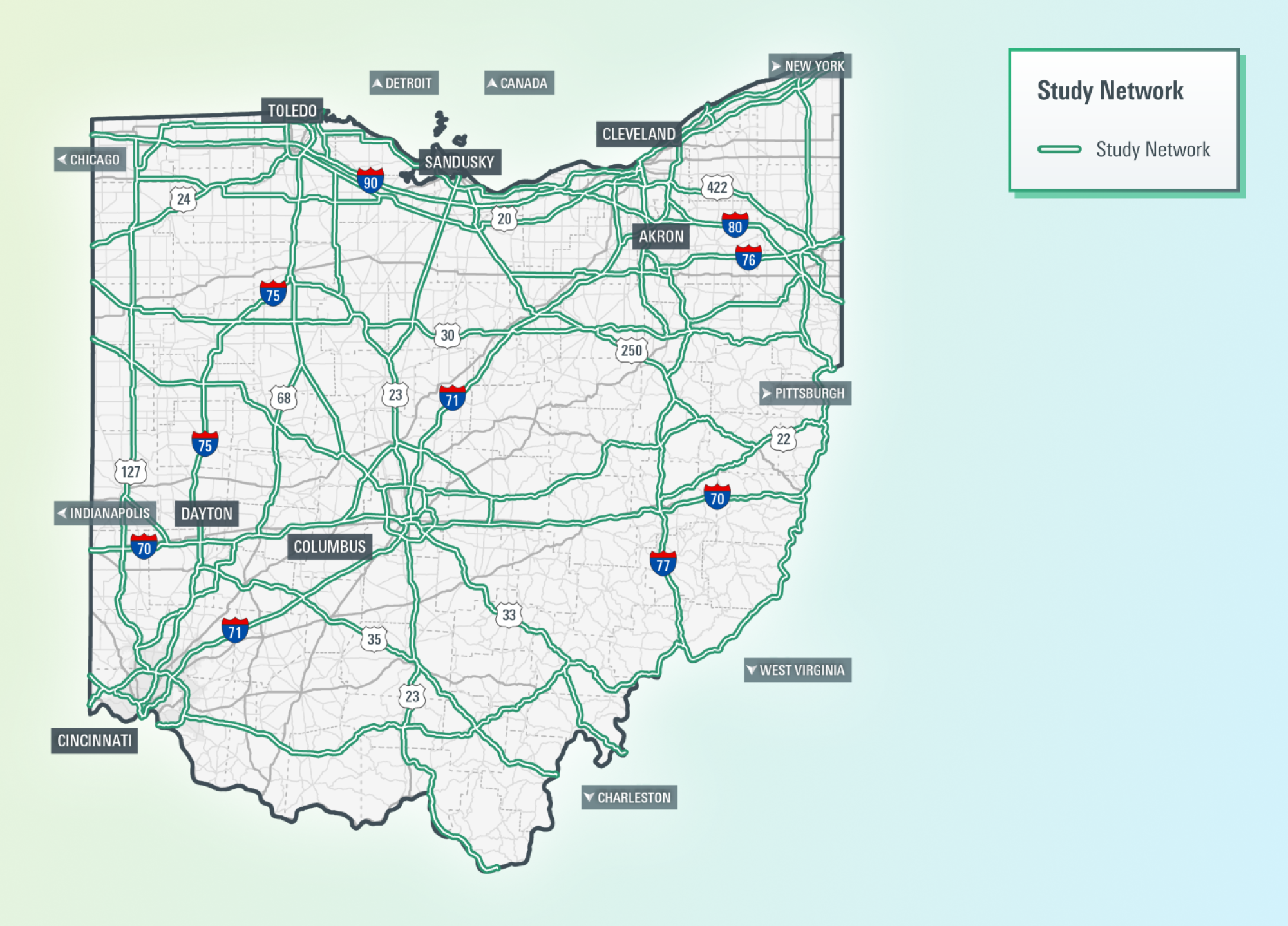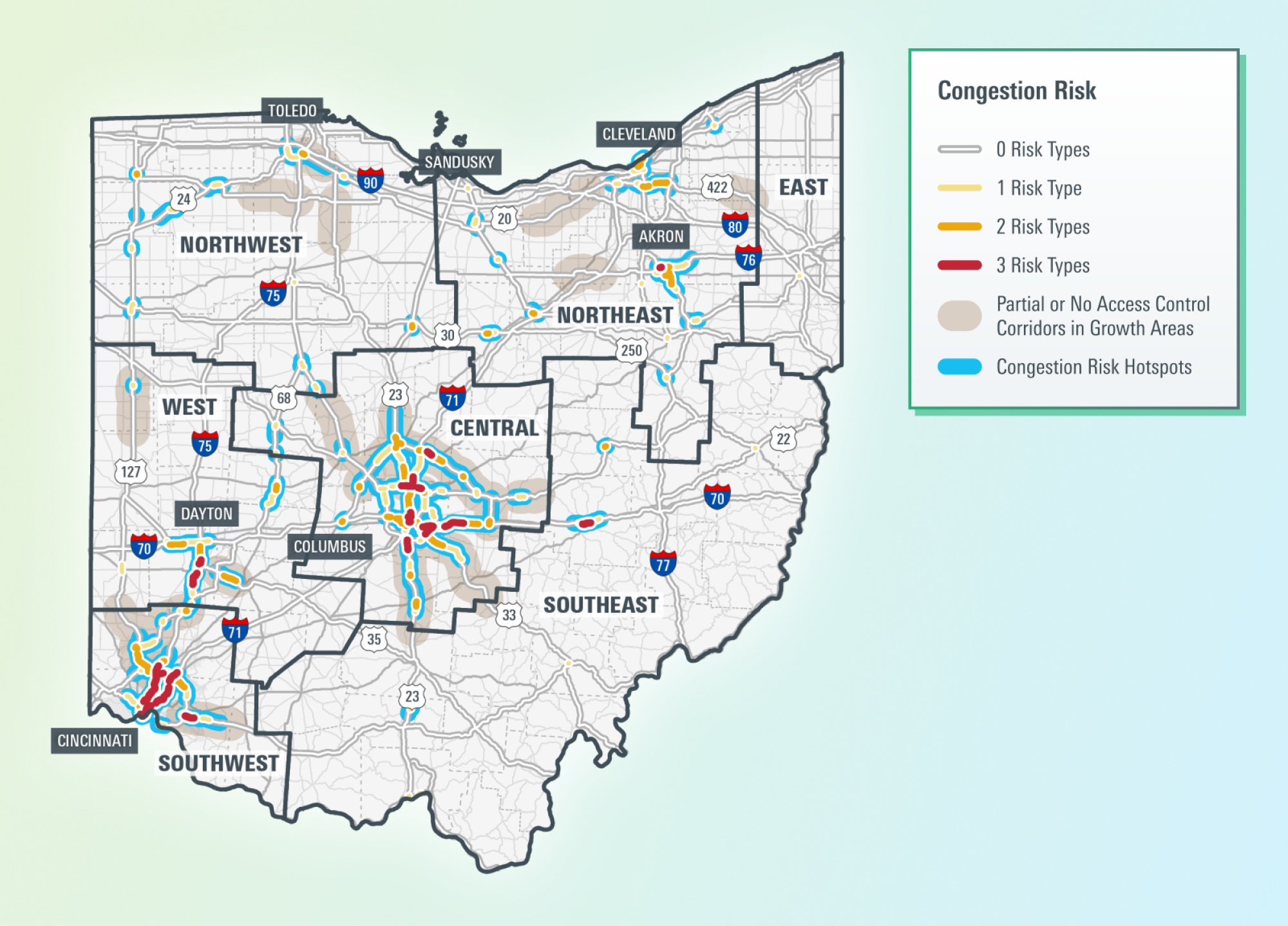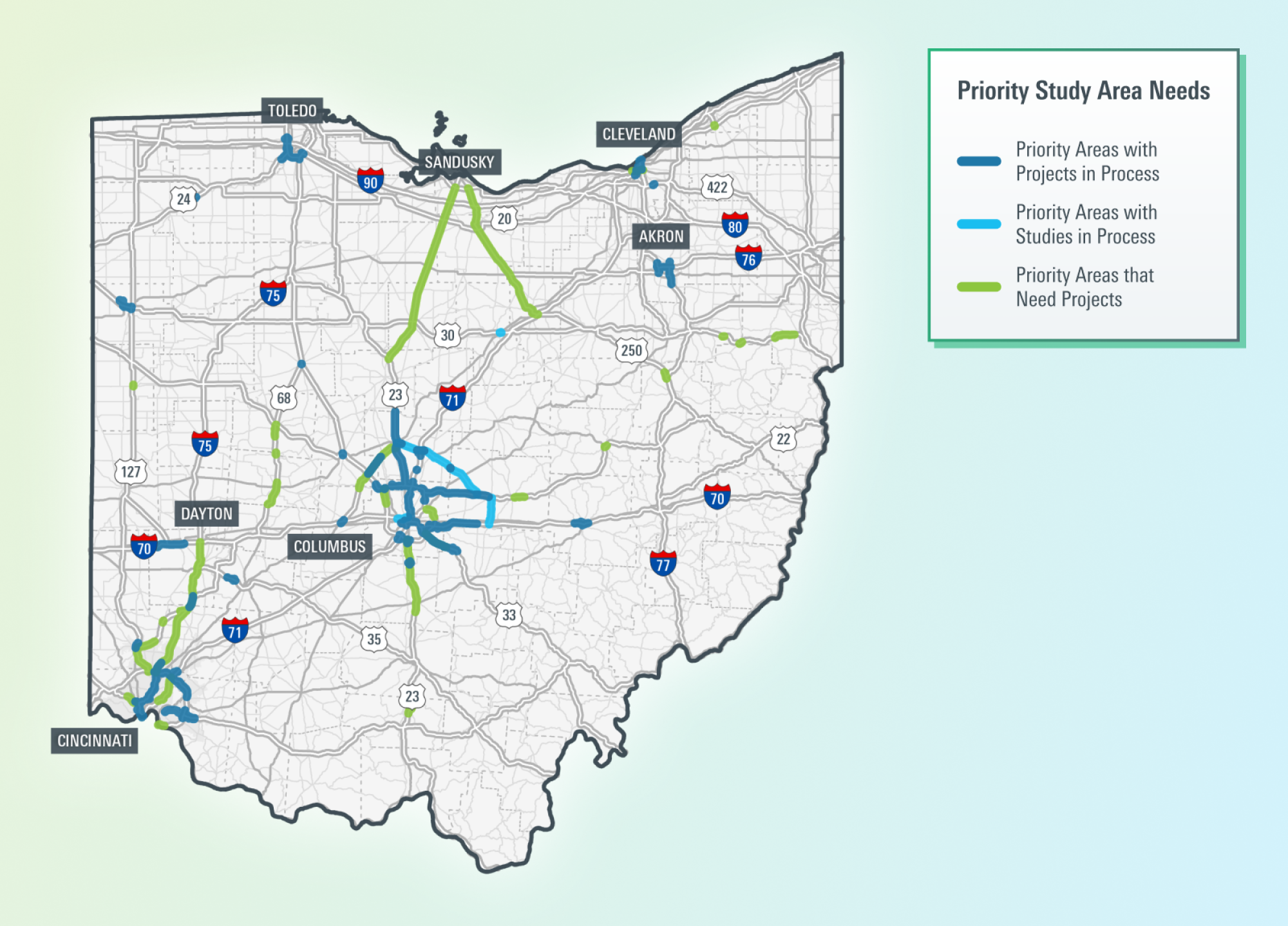
Transportation connectivity and mobility are crucial for economic growth. Business expansion and location decisions are often determined by access to reliable, connected, and safe transportation systems. These systems facilitate the movement of goods along supply chains, connect workers to job opportunities, and enable employers to access talent. Additionally, transportation supports tourism and recreation, enhancing residents' quality of life and benefiting businesses reliant on visitor spending. This is why it is important to study and examine these connections, quantify their economic impact and assess opportunities and risks. We conducted such a study for the Ohio Department of Transportation (ODOT), assessing the state-owned highway network’s capacity to support economic growth.
The ODOT Strategic Transportation & Development Analysis Study
In August 2023, ODOT embarked on a statewide study to better understand how Ohio’s transportation system – particularly its major highways – influences and supports statewide economic growth. The study was sparked by House Bill 23 (effective July 1, 2023), led by Governor Mike DeWine and the Ohio Legislature, but it also sat squarely within ODOT’s broader mission to provide a transportation system that is safe, accessible, well-maintained and positioned for the future. The Strategic Transportation & Development Analysis, published in February 2025, is a groundbreaking study that engaged over 500 stakeholders and examined development trends, including statewide and regional demographics, economic development opportunities and passenger and freight travel needs over the next 10, 20 and 30 years.
Ohio’s interstate highways and a subset of U.S. and state highways carry the majority of vehicle travel in Ohio. This system includes highways of national and statewide significance that connect markets inside and outside of Ohio, rural areas to nearby economic centers, and key intermodal terminals, airports, marine ports and rail to the supply chain.

To understand where this priority system may face risks in supporting economic growth, the study identified current and future congestion risk “hotspots” along this system. Hotspots were identified based on a combination of five different views of congestion risk:
Market Connections – Severe peak period congestion.
Site Development – Congestion impacts associated with build-out of priority development sites.
Workforce Access – Loss of access to jobs or workers within 45 minutes due to congestion.
Business and Logistics Efficiency – Commercial vehicle bottlenecks due to poor reliability.
Quality Places – Risks to corridor mobility due to projected growth and lack of access control.
In addition, six focus corridors were identified for more in-depth analysis given potential risks along these corridors that may limit interregional mobility and future economic growth. Needs assessments on these corridors looked beyond just congestion, focusing on safety, traffic management, asset condition, land use and access management.

From this analysis, 72 congestion risk hotspots were identified on the Study network along with priority needs on each focus corridor. Within these 72 locations and six focus corridors, the team collaborated with ODOT to focus on identifying three sets of priorities:
Locations with ODOT projects in process, either already in construction or in development, that are anticipated to manage congestion risks.
Locations with ODOT studies in process that, when completed, will position ODOT with new projects to manage congestion risks.
Locations that, based on a review of current ODOT plans, programs, and projects, need planning and project development activities to conceptualize strategies to manage congestion risks.

The findings of this review concluded that ODOT is actively developing highway projects to expand capacity and improve operations that will manage congestion risks at 51 of the 72 hotspots. The study also identified strategies that would position ODOT to resolve the remaining 21 hotspots. Download the full report and accompanying appendices, and access a digital interactive mapping tool at transportation.ohio.gov/statewidestudy
Considerations for Your Agency: Is This Study a Right Fit for You?
How can my agency better identify and prepare for both congestion risks and economic development opportunities?
Communities face unique realities regarding how transportation supports economic development and how economic development leverages existing and proposed transportation systems. Baselining the current role of transportation agencies in facilitating economic growth helps agencies understand where they may be falling short and set goals for how transportation investments can position communities to maximize economic returns.
Agencies may face situations where major site development announcements occur, and they are put into a reactive position to enable new transportation connections or workforce access outside of the traditional transportation planning and programming process. In some cases, economic development opportunities are missed if coordination is limited or the transportation system is deemed unable to accommodate new travel demand after site build-out. This type of study can help identify the risks in the system that may limit development, potential solutions to address those risks, as well as foster more proactive coordination among all partners. This type of study can also identify areas where the transportation system is working well and help agencies and developers understand core strengths that can position communities to attract new development.
How can this type of study fit into current agency priorities and planning and programming activities?
Many agencies set a vision, mission, goals, and objectives that connect transportation system priorities and investments to economic growth. The methods used in this study quantify how the transportation system supports growth and identifies risks, and can be applied to any state’s mid- or long-range transportation planning and project development programs. The outcomes can also inform more structured decision-making processes where economic development opportunities are considered, such as project prioritization or strategy for the pursuit of discretionary grants. For example, insights on corridor value, risk, and hotspot identification can help prioritize transportation projects with economic considerations.
This type of study can also be built organically from inside the agency, tied together with other statewide planning initiatives where economic growth is often a key element, such as a Statewide Freight Plan or Long-Range Transportation Plan. This type of study is also successful when support at the highest levels of state government, including the Governor’s Office, can help elevate these efforts and create stakeholder buy-in. Recognizing that transportation access is one of many factors in site location decisions (and typically not the most important), the study showed that greater value is achieved when these initiatives are statewide and multi-agency, and incorporate private sector input.
What steps can I take to determine whether this type of study is the right fit for my agency?
Ohio’s approach leveraged existing resources and on-the-ground realities, including:
Recent statewide economic growth forecasts (reflecting a post-COVID view of the state’s economy and workforce).
A list of priority development sites with substantive information enabling an assessment of site readiness and potential transportation needs and impacts.
A recent and comprehensive statewide freight plan focused on supply chain analysis and forecasts of future demand and trading partners.
Case study examples from recent and ongoing mega site development projects where the State DOT is playing an important role in facilitating site buildout and access.
The study’s strength lies in the combined insights from many agencies and private partners – in Ohio’s case, the Ohio DOT, Ohio Department of Development, and the Governor’s Office of Workforce Transformation regularly coordinated to share insights and review findings. Recognizing where data and insights exist beyond the DOT’s walls can allow the DOT to identify opportunities outside of standard DOT strategic and planning efforts.
How can I address potential barriers to conducting a study of this magnitude?
This type of work requires a clear commitment that allows it to flourish in parallel to the DOT’s other priorities, with the DOT communicating how the work fits into its overall mission, vision, goals and responsibilities while positioning study outcomes to inform planning, programming, delivery, and performance management functions. This topic can spark strong emotions from stakeholders, including perceptions of inequity and disinvestment, debates between managing and encouraging growth, and questions regarding the value of an “if you build it they will come” mentality. In strong home rule states, there is a risk that state-led initiatives regarding development and land use decision-making can be viewed as interfering with local control. Engaging stakeholders early and often and remaining transparent on the objectives and outcomes is critical to success.
Get in touch
If you have questions about how to adjust this study to fit your needs, our team is standing by to answer your questions. By focusing exclusively on transportation planning, we are able to provide our clients with a unique breadth and depth of industry knowledge and experience. We know the issues, the stakeholders, the data, the analytical tools, and the problem-solving processes involved in addressing transportation challenges.
Our experience
We have more than 52 years of experience leveraging technology and ingenuity to advance the world of transportation. Our team has directed or played a key role in 17 statewide Long-Range Transportation Plan updates in the last decade. We worked with multiple states to redesign resource allocation, needs assessments, project prioritization processes, and performance management tools to strengthen the continuity between long-range plans, project prioritization, programming, delivery and system performance. In addition, we’re leading the national conversation about the future of transportation. For AASHTO and the Transportation Research Board, CS is spearheading the development of a shared vision for the next era of transportation in the U.S., including several “moonshot” concepts state DOTs and partners could undertake to advance the vision.
Connect with David Jackson (CS team project manager), Lia Yakumithis, Baird Bream, or John Kaliski to learn more about this project.

